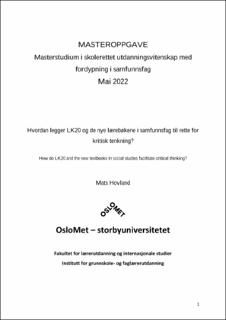| dc.description.abstract | I denne masteroppgaven undersøkes det hvordan LK20 og de nye lærebøkene i samfunnsfag legger til rette for kritisk tenkning. Studien er en kvalitativ, temabasert og komparativ innholdsanalyse. Med en hermeneutisk forankring fortolkes først kompetansemålene i samfunnsfag etter 10. trinn, og deretter innholdet i utvalgte lærebøker. Fortolkningsprosessen følger det andre nivået av den dobbelte hermeneutikken, hvor fortolkning skjer i et samspill mellom del og helhet. Jeg har vært opptatt av å se nærmere på hvordan den norske grunnskolen legger til rette for å følge samfunnsutviklingen. I denne sammenheng ser jeg på hvordan det legges til rette for kritisk tenkning i et utdanningsperspektiv. Her rettes undersøkelsen mot kompetansemål for lærerplanen i samfunnsfag etter 10. trinn og nylig reviderte lærebøker. Til grunn for analyse, viser læreplannivå at tilnærmingen til kritisk tenking beveger seg i en retning av å bli forringet jo nærmere læreplannivå kommer operasjonalisering på kompetansemålnivå. Her er det interessant for studiens formål å forstå hvordan læreplannivå står i forhold til hverandre, og videre hvordan det legges til rette for kritisk tenkning på et lokalt nivå i skolen. Dette undersøkes gjennom to forskjellige analyseskjemaer. I analyseskjema 1 ser studien på grad av kontroll og valgfrihet til kompetansemålenes handling- og innholdsdimensjon. Neste skritt åpner for å undersøke hvordan lærebøkene behandler føringer i LK20. For å kategorisere funnene for analyseskjema 2, benytter studien seg av normative nivå, som viser til stegvise nivå, fra naiv realisme til relativisme, og til slutt kriteriebasert realisme. Under disse nivåene finner undersøkelsen kjennetegn som er overførbart til hvordan lærebøkene med åpne fremstillinger kan legge til rette for kritisk tenkning. Til slutt vil hensikten med å lage to analyseskjema vise en helhetlig forståelse av samsvaret mellom LK20 og læreboka som verktøy i den pedagogiske praksis. Funnene i studien viser en svak innramming i kompetansemålenes innholdsdimensjon for samfunnsfag etter 10. trinn. Lærebøkene tar målene ned til elevenes nivå og knytter de til et konkret innhold. Her viser undersøkelsen at innholdet legger seg til de to øverste normative nivåene, relativisme og kriteriebasert realisme. Det tyder på at lærebøkene fungerer som et godt utgangspunkt for kritisk tenkning. Sett fra studiens forskningsspørsmål tar LK20 og lærebøkene hensyn til utviklingstrekkene i samfunnet, og legger til rette for å utvikle kritisk tenkende medborgere gjennom å konkretisere hvilket innhold kritiske ferdigheter kan nyttes til.
This master's programme examines how LK20 and the new textbooks in social sciences facilitate critical thinking. The study is a qualitative content analysis, which forms the basis for a topic-based and comparative approach to analysis. With a hermeneutic foundation, the competence objectives in social sciences are first interpreted after the 10th grade, and then the content of selected textbooks. The process of interpretation follows the second level of the double hermeneutics, in which interpretation occurs in an interaction between part and whole. I have been curious to take a closer look at how the Norwegian primary school facilitates following societal developments. In this context, I look at how critical thinking is facilitated from an educational perspective. Here, the survey focuses on competence goals for the curriculum in social sciences after the 10th grade and recently revised textbooks. As a basis for analysis, curriculum level shows that the approach to critical thinking moves in a direction of deteriorating, the closer the curriculum level comes to operationalization at the competence target level. Here it is interesting for the purpose of the study to understand how curriculum levels relate to each other, and further how critical thinking is facilitated at a local level in school. This is examined through two different analysis forms. In analysis form 1 the study looks at the degree of control and freedom of choice to the action and content dimension of the competence targets. The next step opens the way for investigating how the textbooks treat guidelines in LK20. To categorize the findings for analysis form 2, the study makes use of normative levels, which refer to step-by-step levels, from naïve realism to relativism, and finally criteria-based realism. Below these levels, the study finds characteristics that are transferable to how the textbooks with open representations can facilitate critical thinking. Finally, the purpose of creating two analysis forms will show a comprehensive understanding of the compliance between LK20 and the textbook as a tool in the pedagogical practice. The findings of the study show a slight framing in the content dimension of the competence goals for social sciences after the 10th stage. The textbooks take the goals down to the students' level and link them to a specific content. Here, the survey shows that the content adds up to the top two normative levels, relativism and criteria-based realism. This suggests that the textbooks serve as a good starting point for critical thinking. Viewed from the study's research questions, LK20 and the textbooks take into account the development trends in society and facilitate the development of critically minded citizens by specifying the content, to which critical skills could be linked. | en_US |
